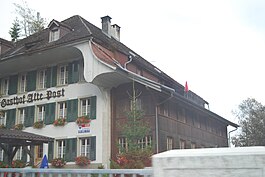Oberwil im Simmental
| Oberwil im Simmental | ||
|---|---|---|

The Gasthof Alte Post in Oberwil im Simmental
|
||
|
||
| Coordinates: 46°39′N 7°26′E / 46.650°N 7.433°ECoordinates: 46°39′N 7°26′E / 46.650°N 7.433°E | ||
| Country | Switzerland | |
| Canton | Bern | |
| District | Frutigen-Niedersimmental | |
| Area | ||
| • Total | 46.09 km2 (17.80 sq mi) | |
| Elevation | 836 m (2,743 ft) | |
| Population (Dec 2015) | ||
| • Total | 820 | |
| • Density | 18/km2 (46/sq mi) | |
| Postal code | 3765 | |
| SFOS number | 0766 | |
| Surrounded by | Boltigen, Därstetten, Diemtigen, Guggisberg, Plaffeien (FR), Rüschegg | |
| Website |
www SFSO statistics |
|
Oberwil im Simmental is a municipality in the Frutigen-Niedersimmental administrative district in the canton of Bern in Switzerland.
Oberwil is first mentioned in 1278 as Oberwile.
During the Paleolithic era (20,000-10,000 BC) humans lived in several caves above the valley floor during the summer. The caves, Schnurenloch, Mamilchloch, Zwergliloch and Chniechälebalm, contained about 5,000 bones from the now extinct cave bear which the inhabitants had butchered. While no human remains were discovered, a number of stone tools were found. Today the tools and bones are at the Historical Museum of Bern while the caves can be visited with tour groups. These caves and other nearby rock shelters continued to be used through the Neolithic, the late Bronze Age and into the Middle Ages. After the collapse of the Western Roman Empire, Alamanni tribes settled in the Simmen valley and established villages and alpine pastures.
In 994, the royal estate at Wimmis and part of Oberwil was donated to Selz Abbey in Alsace. In 1276, Wimmis and Oberwil were given to the new Augustinian Därstetten priory. During the Middle Ages, two castles Festi and Heidenmauer were built above the valley floor. However no records of the castles are still in existence and both have fallen into ruin. By the 12th century the remaining settlements and land were owned by the Freiherr von Weissenburg. In 1439 all the Weissenburg lands, including Oberwil and the surrounding settlements, were acquired by Bern. During the 16th century the entire Simmen valley converted from subsistence agriculture to raising cattle and producing cheese from milk. Today, while the municipality has some small businesses and tourism, the main industry is still agriculture.
...
Wikipedia




